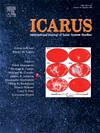Morphometrics of polygonal ground on Earth and Mars: Assessing formation mechanisms from orbit
IF 2.5
2区 物理与天体物理
Q2 ASTRONOMY & ASTROPHYSICS
引用次数: 0
Abstract
Polygonal ground patterns are meter-to-decameter-scale landforms commonly observed on Earth, Mars, and other planetary bodies. They can form through a variety of processes (periglacial, desiccation, volcanic, jointing) and provide insight into geological and environmental conditions that can influence habitability. We focus on the morphometric analysis of these patterns to determine diagnostic signatures which may be used to remotely distinguish between the different formation mechanisms, particularly when in-situ observations are not available. We conducted a survey of patterned ground at 17 Earth sites and 12 Mars sites to determine the diameter distributions, junction angles, junction valencies, circularities, and aspect ratios to determine the characteristics of each polygon type. Our results showed common clustering of morphometric characteristics amongst similar polygon types, though some ambiguities remain between formation endmembers. The size-frequency distributions and the ratio of 90° to 120° junction angles were strong indicators of formation process. The junction angle ratio also reveals the “maturity” of the networks due to periodic or episodic refracturing. Junction valency, circularity, and aspect ratios, also proved valuable as statistical indicators. Our analysis of polygonal patterns located in the Jezero crater floor and margin unit, along with two sites located at Terby crater, are consistent with both volcanic and tectonic jointing processes. Analysis of Mawrth Vallis is strongly suggestive of desiccation. These findings suggest that similar physical mechanisms control polygon formation across planetary bodies, and the study of these patterns on Mars can provide key insights into its geological and climate history, providing clues to potential habitability.
求助全文
约1分钟内获得全文
求助全文
来源期刊

Icarus
地学天文-天文与天体物理
CiteScore
6.30
自引率
18.80%
发文量
356
审稿时长
2-4 weeks
期刊介绍:
Icarus is devoted to the publication of original contributions in the field of Solar System studies. Manuscripts reporting the results of new research - observational, experimental, or theoretical - concerning the astronomy, geology, meteorology, physics, chemistry, biology, and other scientific aspects of our Solar System or extrasolar systems are welcome. The journal generally does not publish papers devoted exclusively to the Sun, the Earth, celestial mechanics, meteoritics, or astrophysics. Icarus does not publish papers that provide "improved" versions of Bode''s law, or other numerical relations, without a sound physical basis. Icarus does not publish meeting announcements or general notices. Reviews, historical papers, and manuscripts describing spacecraft instrumentation may be considered, but only with prior approval of the editor. An entire issue of the journal is occasionally devoted to a single subject, usually arising from a conference on the same topic. The language of publication is English. American or British usage is accepted, but not a mixture of these.
 求助内容:
求助内容: 应助结果提醒方式:
应助结果提醒方式:


